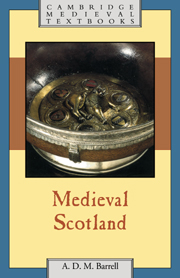Book contents
- Frontmatter
- Contents
- List of figures
- Preface
- List of abbreviations
- Maps
- 1 Early medieval Scotland
- 2 Feudal Scotland
- 3 The transformation of the Scottish church
- 4 The consolidation of the Scottish realm
- 5 The Wars of Independence
- 6 The Stewart kings
- 7 Crown and nobility in later medieval Scotland
- 8 The road to Reformation
- Conclusion
- Select bibliography
- Index
- Title in the Series
1 - Early medieval Scotland
Published online by Cambridge University Press: 05 June 2012
- Frontmatter
- Contents
- List of figures
- Preface
- List of abbreviations
- Maps
- 1 Early medieval Scotland
- 2 Feudal Scotland
- 3 The transformation of the Scottish church
- 4 The consolidation of the Scottish realm
- 5 The Wars of Independence
- 6 The Stewart kings
- 7 Crown and nobility in later medieval Scotland
- 8 The road to Reformation
- Conclusion
- Select bibliography
- Index
- Title in the Series
Summary
An observer of the political configuration of the island of Britain in the sixteenth century would be aware of the existence of two well-defined and long-established kingdoms. The peoples of England and Scotland were often suspicious of one another, sometimes even at war, but both realms could boast a sequence of monarchs stretching back far into the mists of time. From such a vantage point, the development of the two kingdoms might seem an inevitable consequence of historical processes centuries earlier, but in fact there was nothing inevitable about it, especially in the case of Scotland. Rather, the creation of the medieval realm was a remarkable achievement in view of the political, cultural and geographical factors which conspired against it. Other Celtic lands, most notably Wales and Ireland, never achieved unity under a single line of rulers as Scotland did, nor did circumstances ever exist there in which warring tribes and dynasties could be assimilated into a single political entity, even though the ethnic and linguistic diversity of Ireland and Wales was less marked than in Scotland. The Scottish achievement was all the greater for being realised in a land of which large parts are mountainous and suffer very heavy rainfall, rendering them inconducive to settled patterns of agriculture and incapable of sustaining a large population. Land communications between different regions of Scotland were seriously impaired by the existence of extensive areas of barren upland and long firths and sea-lochs, while the relative ease of seaborne travel tended to encourage contact with outsiders rather than fellow-inhabitants of another part of Scotland.
- Type
- Chapter
- Information
- Medieval Scotland , pp. 1 - 11Publisher: Cambridge University PressPrint publication year: 2000



